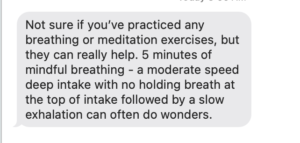
by Nina
Well, it seems that at least one person has been listening to me—my husband! That text message above is what he sent to a colleague who is so stressed out about work that he is having panic attacks. And when Brad told me about the advice he sent, he added that he himself does this type of breath practice after he’s gotten into bed to help him relax before sleep. And he also does this practice when he notices he’s having benign heart palpitations, something he’s suffered from on and off for 40 years, and which seems to happen more frequently during stressful times. He says it is so helpful for both situations.
And, haha, he heard back from his colleague that the colleague’s partner, who is a doctor, gave him exactly the same advice! I’m not sure whether the colleague is actually going to try this or not, but it was quite amazing to hear from my husband that this is his regular practice these days (although in the past he took regular yoga classes, he hasn’t done any yoga asanas in a number of years).
In her recent post Breath is Food for the Body and Soul, Ellen Saltonstall recommended four basic breath practices: 3-Directions Breath, Ujjayi Breath, Kapalabhati Breath, and Nadi Shodhana. But if I had to pick just one breath practice to recommend to people I would pick the one my husband does, which is a form of extending the exhalation. You can simply practice it in the informal way my husband suggested to his colleague by just consciously slowing (lengthening) your exhalation, or you can practice it as a more formal and precise form of pranayama as follows.
Calming Breath Practice: Extending the Exhalation (Vishama Vritti)
With this practice, you gradually extend your natural exhalation, making it longer and smoother, until you reach your comfortable maximum. Breathe through your nose throughout the practice. If your breath becomes labored or uncomfortable in any way, or you start feeling agitated or panicky, stop and return to your natural breath.
- After practicing basic breath awareness for a few minutes, without changing your breath, bring your focus to your exhalations. Using the word om (not the sound) as a measure, as in 1 om, 2 om, 3 om, count the natural length of your exhalations so you get a sense of what the average length is. After each exhalation, allow your inhalations to come naturally.
- When you’re ready, consciously slow your next exhalation so it is 1 to 3 “oms” longer than the natural length, keeping it smooth, comfortable, and without any strain. Follow this longer exhalation with a natural inhalation.
- When you find your comfortable maximum, continue breathing with that extended exhalation and a natural inhalation.
- If you wish to add exhalation pausing to your breath practice, after lengthening your exhalation, first observe the natural pause that always occurs at the end of each exhalation. Then, when you feel comfortable, allow yourself to “rest” in in the pause after the exhalation. If your throat, jaw, tongue, the back of your neck or other areas feel tense, just notice that. Watch your next inhalation building during this rest and “receive” your inhalation when it feels ready.
- As time passes and your breath naturally slows, you may find that you can lengthen your exhalation a bit more by adding one or two more oms.
- At the end of the time you’ve allocated for pranayama, complete your last extended exhalation and then return to breathing naturally as you practice a few more minutes of breath awareness.
• Follow Yoga for Healthy Aging on Facebook and follow Nina on Instagram • Order Yoga for Times of Change here and purchase the companion videos here • Order Yoga for Healthy Aging: A Guide to Lifelong Well-Being here.


Leave A Comment